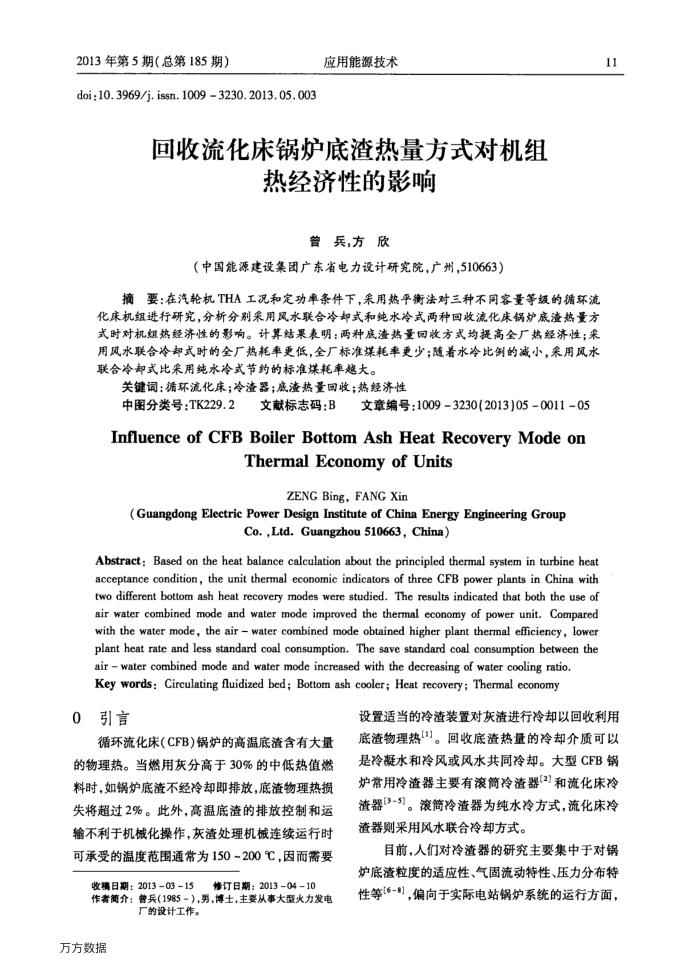回收流化床锅炉底渣热量方式对机组热经济性的影响
内容简介
 2013年第5期(总第185期)
2013年第5期(总第185期)doi:10.3969/j.issn.10093230.2013.05.003
应用能源技术
回收流化床锅炉底渣热量方式对机组
热经济性的影响
曾兵方欣
(中国能源建设集团广东省电力设计研究院,广州,510663)
摘要:在汽轮机THA工况和定功率条件下,采用热平衡法对三种不同容量等级的循环流化床机组进行研究,分析分别采用风水联合冷却式和纯水冷式两种回收流化床锅炉底渣热量方式时对机组热经济性的影响。计算结果表明:两种底渣热量回收方式均提高全厂热经济性;采用风水联合冷却式时的全厂热耗率更低,全厂标准煤耗率更少;随着水冷比例的减小,采用风水联合冷却式比采用纯水冷式节约的标准煤耗率越大。
关键词:循环流化床;冷渣器;底渣热量回收;热经济性
中图分类号:TK229.2文献标志码:B文章编号:1009-3230(2013)05-0011-05 InfluenceofCFBBoilerBottomAshHeatRecoveryModeon
ThermalEconomyofUnits
ZENG Bing,FANG Xin
(Guangdong Electric Power Design Institute of China Energy Engineering Group
Co.,Ltd.Guangzhou510663,China)
Abstract: Based on the heat balance calculation about the principled thermal system in turbine heat acceptance condition, the unit thermal economic indicators of three CFB power plants in China with two different bottom ash heat recovery modes were studied. The results indicated that both the use of air water combined mode and water mode improved the thermal economy of power unit. Compared with the water mode, the air water combined mode obtained higher plant thermal efficiency, lower plant heat rate and less standard coal consumption. The save standard coal consumption between the
airwater combined mode and water mode increased with the decreasing of water cooling ratio. Key words: Circulating fluidized bed; Bottom ash cooler; Heat recovery; Thermal economy
0引言
循环流化床(CFB)锅炉的高温底渣含有大量的物理热。当燃用灰分高于30%的中低热值燃料时,如锅炉底渣不经冷却即排放,底渣物理热损失将超过2%。此外,高温底渣的排放控制和运输不利于机械化操作,灰渣处理机械连续运行时可承受的温度范围通常为150~200℃,因而需要
收璃日期:2013-03-15
修订日期:20130410
作者简介:曾兵(1985-),男,博士,主要从事大型火力发电
厂的设计工作。
万方数据
11
设置适当的冷渣装置对灰渣进行冷却以回收利用底渣物理热]。回收底渣热量的冷却介质可以是冷凝水和冷风或风水共同冷却。大型CFB锅炉常用冷渣器主要有滚筒冷渣器(2]和流化床冷渣器(3-5)。滚筒冷渣器为纯水冷方式,流化床冷渣器则采用风水联合冷却方式。
目前,人们对冷渣器的研究主要集中于对锅炉底渣粒度的适应性、气固流动特性、压力分布特性等[6-8],偏向于实际电站锅炉系统的运行方面,
上一章:锅炉给水泵故障原因分析
下一章:600﹢MW直流锅炉给水改AVT(O)处理的探索